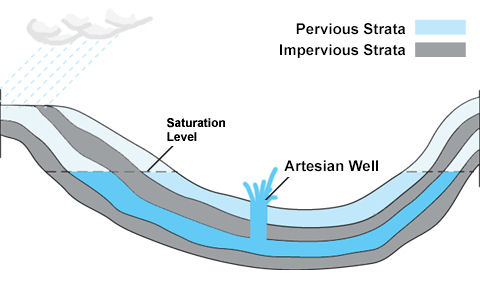abstracted for use on www.pekarske.name This is not your typical geocache, it is an earthcache, you will not a "cache container" rather, an earthcache is designed to bring you to a geological feature. See http://www.earthcache.org/ for further details.
ABOUT THIS LOCATION
Your quest for this Earthcache will take you to private property. Jerome and Susie Washicheck have welcomed visitors to this Spring for many years so please be respectful. You are asked to park on the side of the road and to approach off the gravel pathway created just for visitors. Please stay within the designated areas and do not trespass further onto their land. Please restrict your visit to daylight hours only. Sorry, the landowner has requested and has posted that children should not be near this Spring. The water here is tested on a regular basis and the owners post the actual results. It is not uncommon to find the local residents filling up bottles of this water. Please follow the posted signs stating children are not welcome near the actual spring and please do your best not to disturb the rocks and area. GEOLOGICAL INFORMATION There were four major stages of Ice Age Glaciations that left their mark on the topography and soils of Wisconsin. The last stage, called the Wisconsin stage, ended approximately 10,000 years ago. The outwash plains left stratified deposits consisting of gravel, sand, silt and clay, laid down by water from the melting ice fronts. The water in an artesian well flows from an aquifer, which is a layer of very porous rock or sediment, usually sandstone, capable of holding and transmitting large quantities of water. The geologic conditions necessary for an artesian well are an inclined aquifer sandwiched between impervious rock layers above and below which trap water in it. Water enters the exposed edge of the aquifer at a high elevation and percolates downward through interconnected pore spaces. The water held in these spaces is under pressure because of the weight of water in the portion of the aquifer above it. If a well is drilled (or dug) from a land surface through the overlying impervious layer into the aquifer, this pressure will cause the water to rise in the well. In areas where the slope of the aquifer is great enough, pressure will drive the water above ground level in a spectacular, permanent fountain. Artesian springs can occur in similar fashion where faults or cracks in the overlying impervious layer allow water to flow upward. Water from an artesian well or spring is usually cold and free of organic contaminants, making it desirable for drinking.
Technical data... Pascal's law predicts the theoretical hydrostatic pressure P: where p (rho) is the density of the fluid, g the acceleration due to gravity, and z is the elevation. In practical terms the pressure is expressed as metres water column (zr - zw). HISTORICAL INFORMATION ABOUT THIS SITEThe Springs Era in Waukesha ran from 1868-1918. It all started when suffering from incurable diabetes, Col. Richard Dunbar drank 12 glasses of water from a spring at Bethesda in 1868 and declared himself cured. Dunbar's "miracle" led to the rise of Waukesha's tourist and resort industry, earning a reputation as the "Saratoga of the West." The first of the famous World’s Fairs brought visitors from all across the globe to Chicago in 1893. Expectations in Waukesha were high that a great many of those visitors would take a small detour and visit the “Saratoga of the West”. In the year preceding the World’s Fair, an interesting incident occurred in the then Village of Waukesha. A conflict of interests nearly reached the point of rioting. James E. McElroy was never one to pass up an opportunity. Upon learning of the healing waters of Waukesha, he came upon an idea of purchasing one of the springs, and piping the water down to Chicago. He laid out all his plans, bought Hygena Spring on the corner of Wisconsin and West Avenues, and prepared to lay the pipelines, only to be stopped when the village council denied permission. The city residents wanted visitors of the World Fair to come to Waukesha for the water rather than have Waukesha water go to the Fair. It was on Saturday, May 12, 1892 and rumors concerning a forthcoming ‘invasion’ began to spread through the village. Sure enough, that night, a carload of horses, two flatcars overflowing with pipes and a mob of laborers arrived by railroad. Tensions eased as the men were served lunch and hot coffee before returning to the train. The locomotive departed only to return an hour later and unload it’s passengers once more. This time the villagers toted the famous ‘rail splitter’ canon to the spring, and once again the ‘invaders’ were expelled from Waukesha. James McElroy did not give up his attempt to pump water from Waukesha to the World's Fair. Eventually, he bought this very spring property outside of the village limits and named it Hygena II. He did then obtain permission and laid his pipes. Unfortunately the water, after so many miles of travel, had become stale. Source: http://www.ci.waukesha.wi.us/History/great_water_fight.html
|
|
